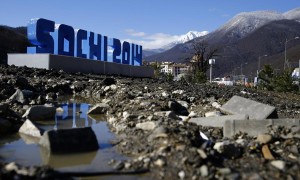
Two years have passed since the Winter Olympics in Sochi, and it is time to take stock. During the construction of the sporting and infrastructural objects, the Russian authorities claimed that the Olympics will: a) make Russia more attractive for foreign investors; b) provide an impetus for Russia’s economic development; c) make Sochi a leading international resort; d) “greatly increase” the tourist flow. Of course, these were not the only promises; there were others, too—but these are easy to compare with reality with the help of statistical data.
a) According to the Bank of Russia, foreign direct investment (FDI) in Russia fell by 3.3 times in 2014—to $20.9 billion, compared with $69.2 billion in 2013. In the following year, 2015, FDI in Russia fell by 92 percent. During the same period of time, FDI across the world increased by 36 percent on the previous year, reaching $1.7 trillion. Foreign direct investment in Russia in 2015 was $1.7 billion. In comparison, FDI in the United States economy that same year was $384 billion. The difference is 226 times.
b) Economic development. In 2014, Russia’s GDP increased by 0.6 percent (the worst result since 2009), and in 2015 even this meager growth gave way to a 3.7 percent contraction of the economy. As for 2016, leading experts are forecasting a continuing recession. In February, the big troika of international rating agencies made their forecasts with regard to Russia’s economy. Standard & Poor’s is predicting a 1.3 percent fall in the GDP in 2016; Moody’s is predicting 2.5 percent; while Fitch is predicting 1.5 percent.
c) Sochi as a leading international resort. There are several international agencies that evaluate which cities can be considered leading resorts. We can study several ratings in order to determine whether Sochi has become a leading international resort. TOP 100 Cities Destination Ranking is being complied by Euromonitor International. According to this rating, only two Russian cities have made the top 100 among the most visited tourist destinations. They are: Moscow, ranked 31, and St. Petersburg, ranked 69. Sochi is not on the list. Another rating is Top-25 World Destination compiled by TripAdvisor, a popular tourist website. In 2016, St. Petersburg once again made this list. Sochi is not to be found. Yet another ranking is Global Destinations Cities Index (GDCI) 2015, which is drawn up annually by MasterCard, and which is based on a detailed study of tourist flows. GDCI ranks 132 world cities according to their popularity among international tourists. Five Russian cities have made the ranking: Moscow (59), St. Petersburg (84), Novosibirsk (117), Yekaterinburg (122), and Vladivostok (131). Once again, no Sochi.
d) Tourist inflow. In the pre-Olympic 2013, 4 million tourists visited Sochi. In the Olympic 2014, this figure rose to 2 million. In 2015, the number of tourists in Sochi was 4.7 million. Thus, there was no multifold increase in the number of tourists. The rise in this figure in 2014-2015 was 17.5 percent, and was likely caused not by the Olympics, but by the fact that fewer Russians travelled abroad because of the devaluation of the ruble. The number of Russian tourists who travelled abroad fell by 31.3 percent in 2015, to 12.1 million people.
 The results are disappointing. The Olympic Games did not make Russia more attractive for foreign investors; the Russian economy is in crisis; Sochi has not become a leading international resort; while the annual tourist inflow grew insignificantly, and only thanks to impoverished domestic tourists.
The results are disappointing. The Olympic Games did not make Russia more attractive for foreign investors; the Russian economy is in crisis; Sochi has not become a leading international resort; while the annual tourist inflow grew insignificantly, and only thanks to impoverished domestic tourists.
It is likely that, were it not for the annexation of Crimea and the Russian military intervention in southeastern Ukraine that immediately followed the Sochi Olympics, economic results for Sochi and for Russia as a whole in the past two years would have been less unfortunate. But, as we know, history knows no “if”.





